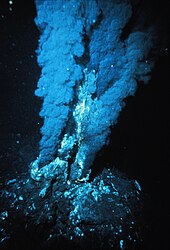

Achemotroph Greek words “chemo” (meaning chemical) and “troph” (meaning nourishment) is an organism that obtains energy by the oxidationofelectron donors in their environments.[1] These molecules can be organic (chemoorganotrophs) or inorganic (chemolithotrophs). The chemotroph designation is in contrast to phototrophs, which use photons. Chemotrophs can be either autotrophicorheterotrophic. Chemotrophs can be found in areas where electron donors are present in high concentration, for instance around hydrothermal vents.

Chemoautotrophs are autotrophic organisms that can rely on chemosynthesis, i.e. deriving biological energy from chemical reactions of environmental inorganic substrates and synthesizing all necessary organic compounds from carbon dioxide. Chemoautotrophs can use inorganic energy sources such as hydrogen sulfide, elemental sulfur, ferrous iron, molecular hydrogen, and ammonia or organic sources to produce energy. Most chemoautotrophs are prokaryotic extremophiles, bacteriaorarchaea that live in otherwise hostile environments (such as deep sea vents) and are the primary producers in such ecosystems. Chemoautotrophs generally fall into several groups: methanogens, sulfur oxidizers and reducers, nitrifiers, anammox bacteria, and thermoacidophiles. An example of one of these prokaryotes would be Sulfolobus. Chemolithotrophic growth can be dramatically fast, such as Hydrogenovibrio crunogenus with a doubling time around one hour.[2][3]
The term "chemosynthesis", coined in 1897 by Wilhelm Pfeffer, originally was defined as the energy production by oxidation of inorganic substances in association with autotrophy — what would be named today as chemolithoautotrophy. Later, the term would include also the chemoorganoautotrophy, that is, it can be seen as a synonym of chemoautotrophy.[4][5]
Chemoheterotrophs (or chemotrophic heterotrophs) are unable to fix carbon to form their own organic compounds. Chemoheterotrophs can be chemolithoheterotrophs, utilizing inorganic electron sources such as sulfur, or, much more commonly, chemoorganoheterotrophs, utilizing organic electron sources such as carbohydrates, lipids, and proteins.[6][7][8][9] Most animals and fungi are examples of chemoheterotrophs, as are halophiles.
Iron-oxidizing bacteria are chemotrophic bacteria that derive energybyoxidizing dissolved ferrous iron. They are known to grow and proliferate in waters containing iron concentrations as low as 0.1 mg/L. However, at least 0.3 ppm of dissolved oxygen is needed to carry out the oxidation.[10]
Iron has many existing roles in biology not related to redox reactions; examples include iron–sulfur proteins, hemoglobin, and coordination complexes. Iron has a widespread distribution globally and is considered one of the most abundant in the Earth's crust, soil, and sediments.[11] Iron is a trace element in marine environments.[11] Its role as the electron donor for some chemolithotrophs is probably very ancient.[12]
{{cite journal}}: CS1 maint: multiple names: authors list (link)
1. Katrina Edwards. Microbiology of a Sediment Pond and the Underlying Young, Cold, Hydrologically Active Ridge Flank. Woods Hole Oceanographic Institution.
2. Coupled Photochemical and Enzymatic Mn(II) Oxidation Pathways of a Planktonic Roseobacter-Like Bacterium Colleen M. Hansel and Chris A. Francis* Department of Geological and Environmental Sciences, Stanford University, Stanford, California 94305-2115 Received 28 September 2005/ Accepted 17 February 2006